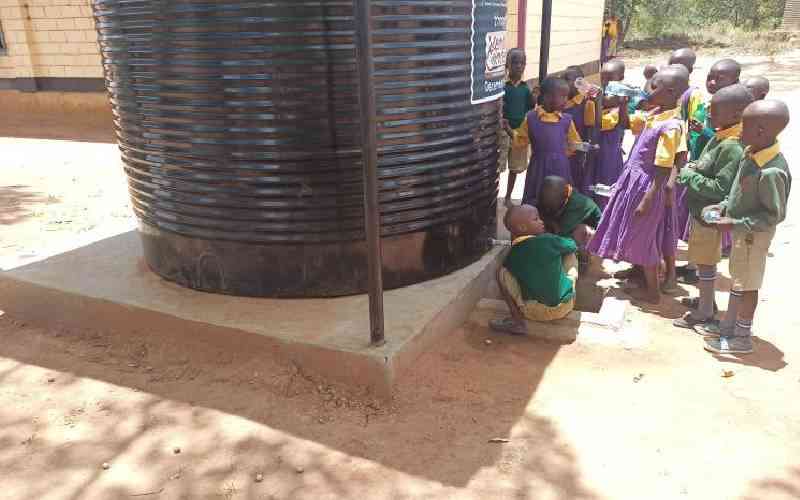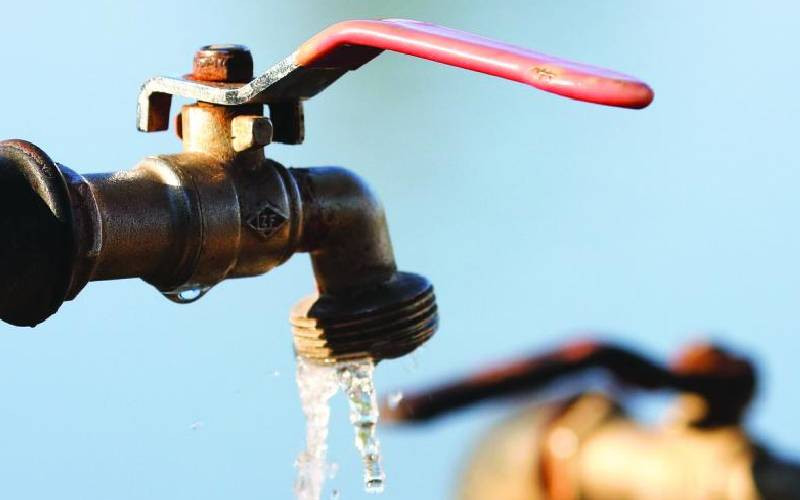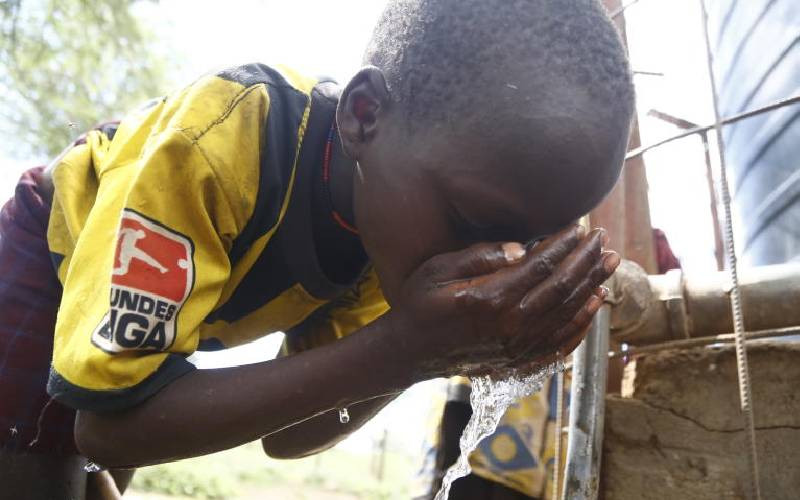
Residents of many of Nairobi’s suburbs are up in arms over persistent water shortage. They say taps run dry for much of the week, despite paying monthly utility bills to the Nairobi Water and Sewerage Company (NWSCO).
The National Housing Corporation Estate in Lang’ata is one of the new developments affected, says a frustrated tenant, Jack Opiyo.
Opiyo believes the shortage is caused artificially by cartels working in cahoots with authorities who encourage private vendors to sell water to tenants of the 900 flats at estate expensively.
He says NCWSC has a main valve outside the estate on the access road — that is the valve they use to turn on water on Sunday afternoons before they close it on Tuesday afternoons.
“Meaning we should have water from Sunday afternoon to Tuesday lunch time. But since June, the water pressure suddenly dropped such that only ground floor, and some first floor flats, have been receiving water,” he says.
Before June, the pressure was sufficient to supply all homes and tenants would only buy water when they exhausted their overhead storage capacity. But that changed in June.
Following numerous complaints to the regional manager and senior engineers, NCWSC held an open forum with tenants in the estate on July 31, but the shortage persisted even though the country had received one of the heaviest rains in preceding months, filling up dams and reservoirs that supply Nairobi with water.
By this time, some houses had not received water for up to eight weeks, sometimes forcing tenants to spend up to Sh4,000 every week to buy water.
“From the open forum, it emerged that NCWSC technicians had been coming to the estate and interfering with the valves within the estate to regulate water supply,” says Opiyo. After more sustained complaints, supply was briefly restored. Water came with so much pressure that some houses received water for the first time in three months.
It is responses such as these that have residents convinced that cartels in NWSCO are working with water vendors to create artificial shortages to compel them buy water from other sources.
However, the head of Corporate Communications at NWSCO Mbaruku Vyakweli, believes this theory is far-fetched.
“We are not aware of cartels in the system, what we know are the illegal connections that result in leakages hence causing the above deficit,” said Vyakweli.
Nairobi Governor Evans Kidero recently weighed in on the rationing following complaints by Woodley residents and said there were ongoing efforts to increase supply.
“We have two supply regimes for Woodley—those around Nakumatt Prestige get water on Sundays 8 am to Mondays 8 am; and those near Adams get water on Tuesdays 9 am to Wednesday 9 am. Nairobi County and Nairobi Water jointly are in the process of carrying out improvement for Kinangop Road and we are in consultation with residents association,” said Kidero
Stay informed. Subscribe to our newsletter
However, city residents complain that despite talk of grand plans to increase supply, little is done to apprehend those deliberately cutting off supplies. They say where consumers have been exploited by water vendors especially in informal settlements, new programmes to provide water more cheaply have been launched.
Distribution programme
The informal settlements in Mathere are among those that have benefited. Vyakweli says the county water distribution programme in Mashimoni, Mathare sub-county uses ATMs and with Sh2, consumers can purchase a 20-litre jerrican of water.
Official records show that consumers sometimes pay up to 25 times more for water when they purchase it from private vendors. They sometimes pay Sh1,000 for 1,000 litres, way above the Sh18 per 1,000 litres that NWSCO recommends.
City dwellers, especially in Eastlands, get most of their water from handcart pushers and bowsers which sell a 20-litre jerrican at between Sh20 to Sh50. The areas of Nairobi affected include Imara Daima, Utawala, Embakasi, Mukuru Kwa Njenga slums, Pipeline, Komarock, Tassia, Kayole, Buruburu, Umoja and Donholm.
The vendors have also diversified to the southern part of Nairobi and now play their trade in Kibera’s Ayany, Lang’ata and Woodley areas.
There are currently four sources of water for Nairobi — Ndakaini Dam, Ruiru Dam, Sasumua Dam and Kikuyu Springs.
Athi Water CEO Malaquen Milgo says the perennial water shortage is as a result of excess demand.
“The solution lies in improving the water distribution system to ensure that there is maximum coverage,” says the engineer, basing his assessment on the Nairobi Water Masterplan Study conducted by Athi Water in 2012.
He is convinced that the construction of the Northern Collector Tunnel through Athi Water will reduce the shortage.
“The Northern Collector Tunnel project is a new bulk water supply system for Nairobi City designed to deliver 140,000 cubic metres per day,” says Milgo.
This project will encompass the Northern Collector Tunnel I, (to divert defined flood flows from rivers Maragua, Gikigie and Irati into Thika Dam), raw and treated water transmission pipelines up to Kabete and the development of a water treatment plant at Kigoro. It has a component that involves the upgrading of the Nairobi city water distribution system.
The tunnel will transfer raw water from intakes at the Maragua, Gikigie and Irati Rivers to an outlet at the Githika River near Makomboki, upstream of the existing Thika Reservoir (Ndakaini Dam).
The final design for the pipeline is ongoing while a design and build package is being assembled for the water treatment plant at Kigoro. Authorities hope the project will be completed it in the next two years.
This projected demand for water is contained in the master plan that Athi Water launched in 2012.
The master plan contains a water supply development blueprint to meet the short, medium and long term water demand for Nairobi City and 13 satellite towns of Kikuyu, Ruiru-Juja, Kiambu, Karuri, Githunguri, Mavoko, Ngong, Ongata Rongai, Kiserian, Thika, Gatundu, Limuru, Lari (Uplands and Kimende), Tala-Kangundo).
Athi Water Services Board, with support from the Government through the Ministry of Water and Irrigation and various development partners, has rehabilitated water supplies, installed new pipelines and drilled boreholes.
The 1998 sanitation masterplan indicates that some 50km of trunk sewers have been laid, while work on a 113km section is in progress. In addition lateral sewers in priority areas have been laid.
It says the Dandora Sewage Treatment Plant has been expanded and will be modernised to generate energy.
Similarly rehabilitation of Kariobangi Sewerage Treatment Plant is about to start and will include energy generation.
The overall goal is to ensure reliability and security of water supply for Nairobi and satellite towns through optimal use of the existing facilities, an increase of surface water storage sources and diversification of water sources.
“We have since started the implementation of the Master Plan with the support of various development partners,” added Milgo.
“The total water supply to Nairobi City and envelope satellite towns is at the moment 580,000 cubic metres per day against a demand of 750,000 cubic metres per day. This demand is projected to increase to 860,000 cubic metres per day by 2017 and 1.55 cubic metres per day by 2035,” says Milgo.
This is far below the internationally required benchmark of 1,000 cubic metres per capita a year.
 The Standard Group Plc is a
multi-media organization with investments in media platforms spanning newspaper
print operations, television, radio broadcasting, digital and online services. The
Standard Group is recognized as a leading multi-media house in Kenya with a key
influence in matters of national and international interest.
The Standard Group Plc is a
multi-media organization with investments in media platforms spanning newspaper
print operations, television, radio broadcasting, digital and online services. The
Standard Group is recognized as a leading multi-media house in Kenya with a key
influence in matters of national and international interest.
 The Standard Group Plc is a
multi-media organization with investments in media platforms spanning newspaper
print operations, television, radio broadcasting, digital and online services. The
Standard Group is recognized as a leading multi-media house in Kenya with a key
influence in matters of national and international interest.
The Standard Group Plc is a
multi-media organization with investments in media platforms spanning newspaper
print operations, television, radio broadcasting, digital and online services. The
Standard Group is recognized as a leading multi-media house in Kenya with a key
influence in matters of national and international interest.









